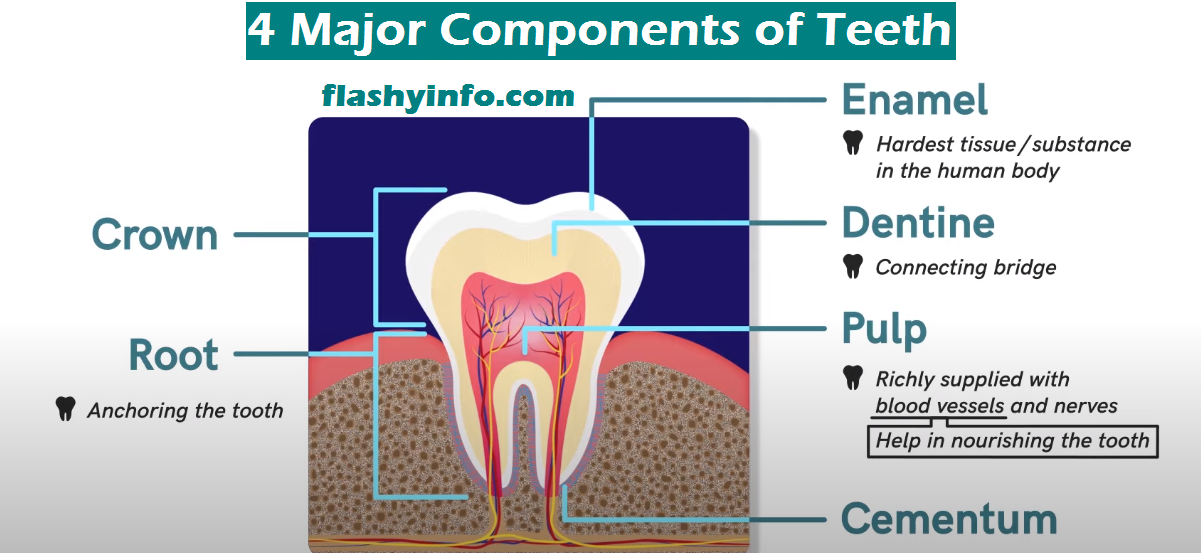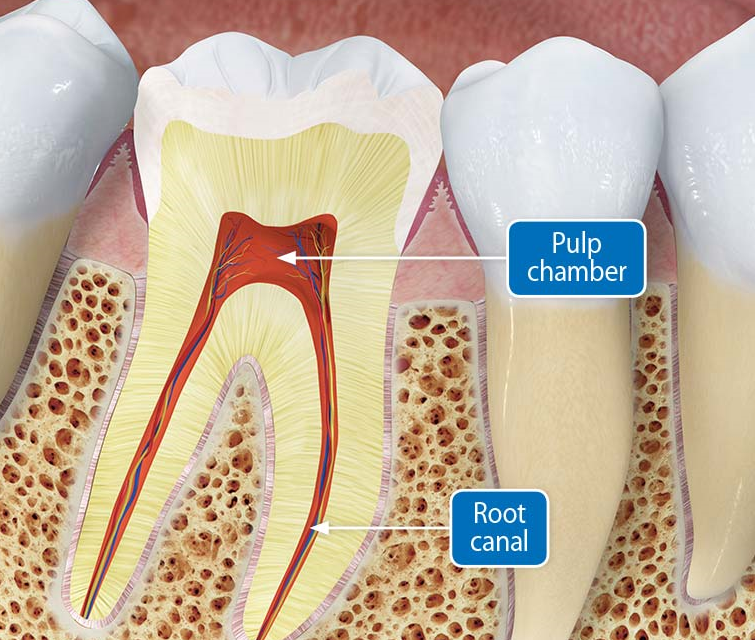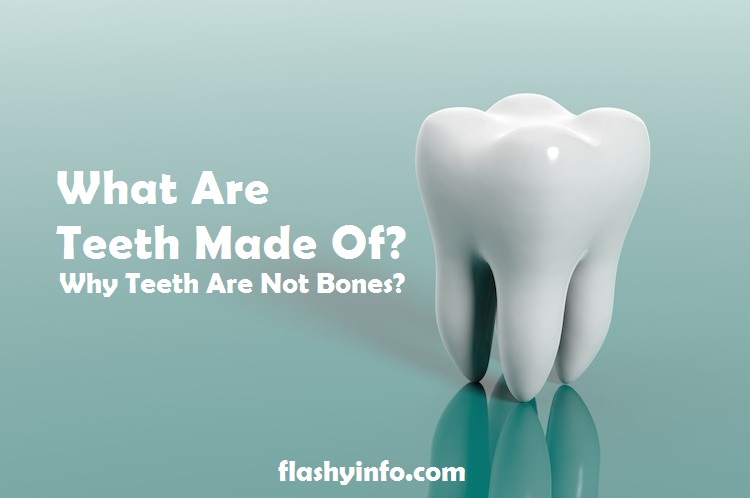What Are Teeth Made Of? Why Teeth Are Not Bones?
Have you ever wondered what are teeth made of? Teeth are made of four main components: Dentin, Enamel, Cementum, and Pulp chamber. Learn more about them in this article. Next, let’s discuss the different functions of these components. Dentin surrounds the pulp and makes up most of the tooth. It makes teeth look off-white and is the second hardest component of teeth, next to the enamel. But unlike enamel, dentin is much less strong than enamel.

1. Dentin

The main portion of your teeth is composed of dentin. This yellow-colored layer is composed of 70-72% inorganic matter, 20% organic matter, and 10% water. It lies beneath the enamel on the crown and cementum at the root. Compared to the enamel, dentin is less mineralized and less hard. It also has a higher level of elasticity. Because of this, dentin supports the enamel and keeps it from cracking or fracturing.
What is dentine made of?
A dentist can prepare dentin by removing the outermost layer of the tooth. Dentin is made of microscopic channels called dentinal tubules. These tubes extend outward from the dentinoenamel or cementum junction. They create an S-shaped path, extending outward. Dentin is permeable, which increases the sensitivity of tooth pain. It also increases the rate of tooth decay.
Pre-dentine is composed of 90% type I collagen and 10% non-collagenous proteins. These fibrils undergo lateral aggregation. The diameter of dentin fibrils varies depending on the predentin layer. Proximal predentin fibrils are 20 nanometers in diameter, while central and distal predentin fibrils are 55-75 micrometers in diameter.

The dentin cannot repair the damage caused by wear and decay. The crown is the visible portion of your tooth. The dentin layer also includes the gums, which cover the roots and unerrupted teeth.
There are three forms of dentin
- Primary Dentin
- Secondary Dentin
- Tertiary Dentin

Primary dentin is the most visible type. Secondary dentin develops after tooth root formation, while tertiary dentin is formed in response to an external stimulus. Primary dentin is located between the enamel and the pulp chamber, while mantle dentin forms closest to the enamel. Mantle dentin is about 15 to 20 micrometers wide, and it consists of newly differentiated odontoblasts.
2. Enamel

The enamel layer protects the tooth against cavities and wear and tear and acts as a protective barrier. The dentin layer is made up of nerves, blood vessels, and connective tissue. Dentin surrounds the root of the tooth. The dentin and enamel cover the pulp chamber.
Characteristics of enamel
- The color of the enamel on your teeth varies from yellow to grayish white and reflects the degree of mineralization on the tooth surface.
- Ameloblast cells are responsible for the formation of enamel.
- Enamel is the most durable substance in the human body and is composed of 95%-98% inorganic materials, while water comprises between 1% and 4%.
- The enamel layer is composed of calcium and phosphate ions, which form a strong hydroxyapatite crystal.
- Enamel also contains an organic substance called enamelin proteins.
- Enamel is the hardest substance in the body and is the layer that protects the tooth.
- Enamel can regenerate, but it cannot repair significant damage to teeth. Therefore, proper care of your teeth is essential to ensure their health and longevity.

The process of enamel formation
The process of enamel formation has long been a mystery. It is not completely clear how enamel is constructed, but scientists now have some answers. Amelogenin is a protein in human teeth that self-assembles into ribbons, which support the growth of hydroxyapatite crystals. However, there is still some doubt as to whether enamel can be grown in a test tube. In the meantime, researchers are trying to develop artificial enamel that can help protect teeth.
Related: 5 BENEFITS OF GETTING FLEXIBLE DENTURES
3. Cementum

A tooth’s cementum is composed of a thin layer of tissue that forms a bond with the alveolar bone. Cementum forms continuously throughout the lifetime of the human body, and it functions as a support system for the teeth. It exists in two types, cellular cementum and acellular cementum. Cellular cementum forms the apex and coronal root, while acellular cementum is found on the apical root.
The origin of the cementum is controversial. Several authors have suggested different origins for the cementum. Some researchers have even found no discernible boundary between the cementum and dentin. This controversy has led to many scientists to disagree on its exact role in the development of teeth. The cementum is a critical component of the dental structure, and understanding the structure of the tooth is essential to achieving optimal oral health.
The dentin has a network of nerves and blood vessels that can cause pain if it does not have adequate protection.
What are cementoblasts
As a person ages, the cementum layer on teeth increases in thickness. This layer is composed of cells called cementoblasts that secrete intrinsic fibers along finger-like processes that surround extrinsic fibers in the cementum. Because this cementum is relatively strong, it is able to hold teeth together and resist abrasion. As a result, the cementodentinal junction (CEJ) becomes relatively smooth.
Importance of cementum layer
The cementum layer on the surface of the roots of the teeth is one of the most important parts of the tooth’s anatomy. It connects the teeth to the jawbone and is much softer than enamel. It also protects the root within the gums, which is covered by dentin, which is the bone-like substance that forms the root.
4. Pulp chamber
Despite the wide range of tooth restoration procedures, many people are still unaware of what the pulp chamber of the teeth is and how it functions. This article explores this subject further. The study was carried out using a dial caliper with 0.1 mm precision. The average wall thickness of the buccal and lingual chambers and the enamel-cementum junction was measured. The average thickness of these three components was compared to determine the failure threshold.

A dental pulp chamber is a structure found beneath the dentin layer of the tooth and contains blood vessels and nerves that provide nourishment to the tooth. When a cavity develops into the dentin layer, it can lead to pulpitis or inflammation of the tooth’s pulp. Inflammation of the pulp chamber is typically treated with a filling or root canal, but in some cases, extraction is necessary. If the pulpitis is left untreated, the dentist may prescribe antibiotics.
The study also measured the temperature rise of the pulp chamber, which is composed of the dentin and pulp. The temperature of the adjacent surface of the pulp chamber never exceeded 5.5degC. After this, the composite was applied and incrementally cured. The temperature of the pulp chamber was simultaneously measured using a k-type thermocouple. The results indicate that the dental composite has a beneficial effect on tooth restoration.
The A4 cell line derived from the molar pulp of a mouse embryo is responsible for the reparative dentinal bridge. The A4 cells implanted into the tooth after exposure induces reparative dentin-like structures. These precursors are important for pulp regeneration and are also associated with the development of osteodentin. The regeneration of the dentine-pulp complex involves both inflammatory and non-inflammatory processes.
Also Read: 7 Signs It May Be Time to Get Braces
Alveolar bone

The alveolar bone supports the roots of the teeth and the cementum on the surface. The alveolar bone is uniformly thick at the posterior portion of the jaw and thinner at the anterior portion of the jaw. It is also a protective layer that snugly encompasses the exposed surfaces of the teeth. It is made of four major constituents: dentin, cementum, calcaneus, and periapical ridge.
The formation of the alveolar bone starts with the eruption of the developing tooth. This is followed by the formation of the root, which occurs in the mouth through a process called the alveolar process. In this process, the dental follicle gives rise to cementoblasts, which deposit cementum onto the surface of the alveolar bone. Other mesenchymal cells then differentiate into osteoblasts and fibroblasts, which form sockets in the alveolar process.
The alveolar bone proper serves as the attachment site for the sharpey fibers of the PDL, which are collagen fibers that are organized in bundles and calcified within the bone. Sharpey fibers provide a firm attachment between the tooth and the bone. The bundle bone joins the adjacent lamellar bone and is most important to the movement and disease processes of the periodontium. The alveolar bone proper contains sharpey fibers, which are similar to the cementum fibers.
The composition of alveolar bone is 67% inorganic and 37% organic material. Organic material consists of collagen and non-collagenous material. The cellular component of bone is made up of osteoblasts, osteocytes, and osteoclasts. These cells play important roles in maintaining the health of the teeth. This bone also serves as the foundation of the periodontal ligament.
For More Articles Visit: Flashy Info







